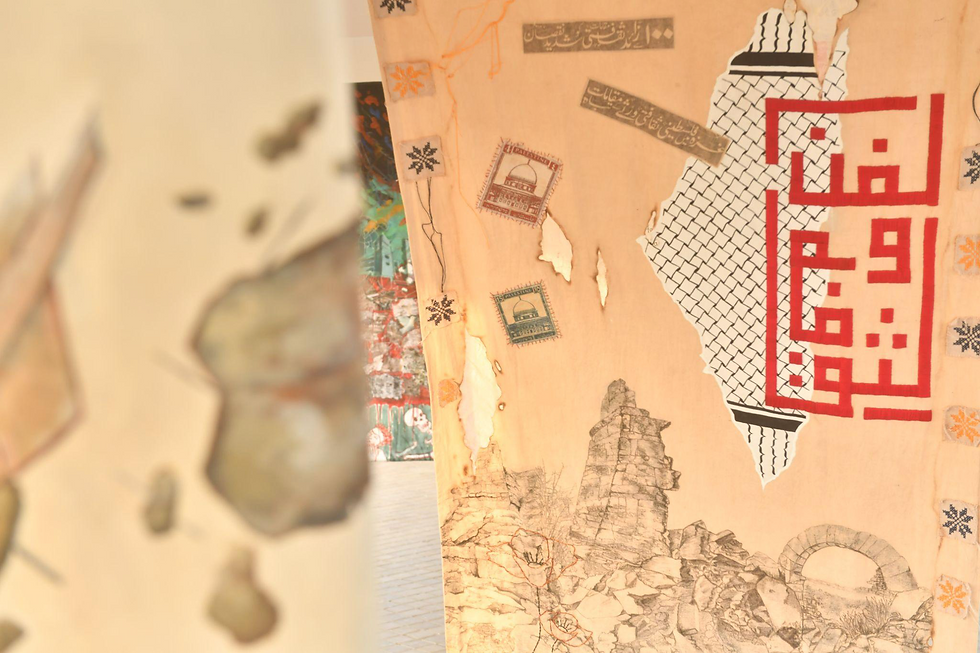A Tapestry of Voices
- The Aleph Review

- Nov 1, 2024
- 2 min read
Updated: Nov 4, 2024
Nayab Shaikh
A look inside resistance art in honour of Palestine at KB24. This is part of our ongoing coverage of KB24.
At the Karachi Biennale, the city became a sanctuary for shadows, a heartbeat for silenced voices, and an anthem for enduring roots. Here, the art of Palestine, featured at Bagh Ibn Qasim, was reborn, threaded, painted, and woven into a tapestry of resistance and memory. Entitled Artist of Gaza Lives in Our Heart, each piece, Pakistan’s artists called forth the resilient spirit of a people whose culture defies destruction, their voices mingling with whispers of olive trees, scarlet threads, and echoes of a land stitched with history.

Kinnaird College for Women’s Silenced Roots of Palestine emerged as a ghostly landscape, where the ground bore wounds and skies mourned the fading voices of dabkeh dancers. The 6x4-foot canvas revealed an aerial view of a world transformed into rubble yet alive with a pulse. The keffiyeh, draped over its surface like an ancestral blessing, and the map of Palestine stitched on the reverse, held each viewer close to the land’s memory.

The University of Balochistan’s work burned like an enduring flame. Rendered in soft relief, this piece celebrated the strength of Gaza’s identity through vibrant motifs and sorrow-tinged figures, a tribute to Palestinian artists like Mina Mattar. Its watermelon slices and flowers, symbols of a culture that blooms amidst suffering, offered viewers a portrait of hope intertwined with grief—a story of resilience made visible through colour and form.
The Karachi Biennale, with its pulse of solidarity, provided the perfect setting for each piece, where Karachi University’s untitled fabric work lay like a scarred prayer across a canvas dyed in tea wash. This piece, held together with bandages, told of heritage sites reduced to dust, the embers of memory woven into burned and frayed edges, symbolising the unity that binds fractured identities.
Then, like the hymn of a stitched lullaby, Karachi School of Arts offered Stitched Together: A Tapestry of Resistance. Here, pieces of old school uniforms became the cloth of memory, each linocut-printed with motifs of faded terracotta and mustard. Stitches ran deep in reds, connecting generations, holding fragments of forgotten dreams. It was as if each thread whispered the defiance of Palestinian students and teachers, of artists whose schools lie buried yet whose spirits rise.

Fractured Harmony: A Cry for Peace by Shaheed Allah Buksh Soomro University stood as a beacon of chaos and hope, where shattered glass gave way to doves, and broken dreams sought the light of peace. Fatima Jinnah Women University’s Fragments of Al Qarara: A Legacy Lost mourned the vanished Al Qarara Museum, its frayed fabrics evoking a fragile yet fiercely protected heritage.
The Karachi Biennale became a living tapestry, binding Palestine’s spirit to the city’s soul. In each brushstroke, stitch, and thread, Pakistan’s artists honoured stories that refuse to be silenced. Art became a language of defiance, each piece alive with the memory and strength of those who persist. Walking through these pieces was like entering a sacred space, where sorrow transformed into resilience, and loss grew roots.










For fans who crave a glimpse behind the paywall, onlyfans videos free offers a taste of what’s hidden beyond the premium space. It’s where fantasy meets reality, and viewers get to experience intimate moments once reserved for subscribers only.